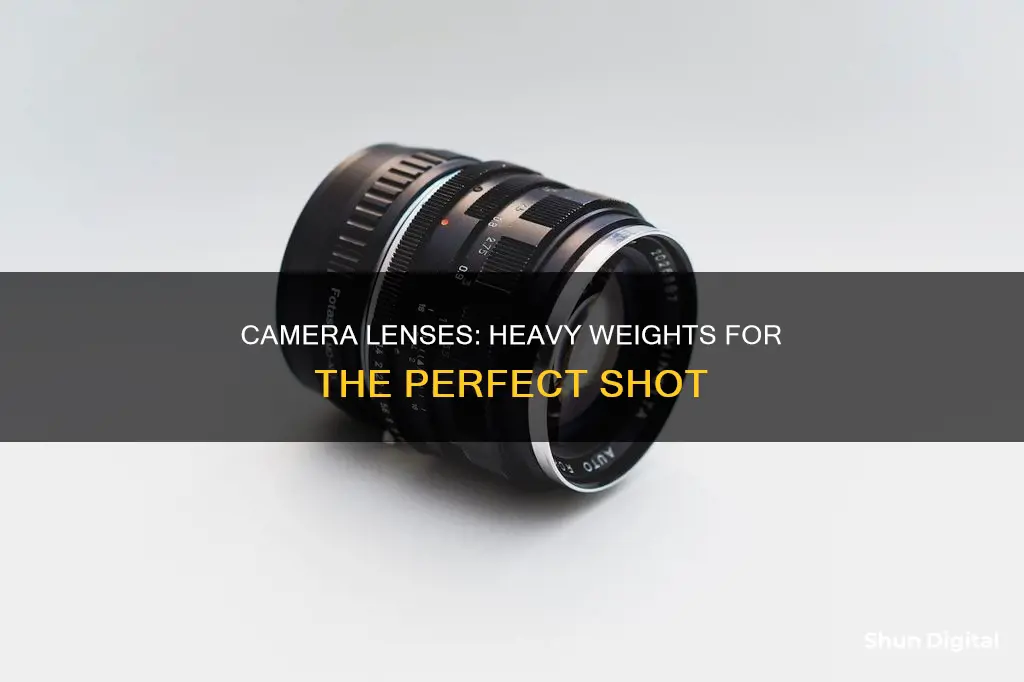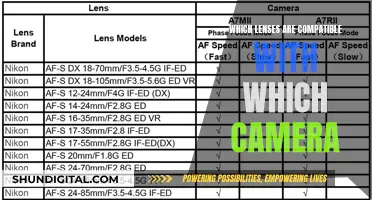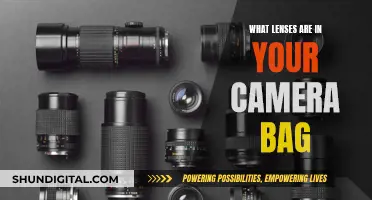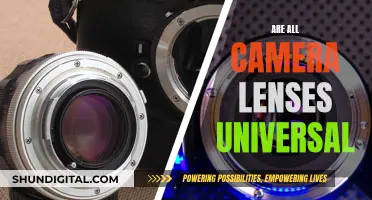
Camera lenses vary in weight, with some weighing as little as a few hundred grams, while others can reach up to 2kg or more. The weight of a lens depends on various factors, including its type, focal length, and construction. Lenses with larger apertures and longer focal lengths tend to be heavier, as they require more glass elements and a larger build. Additionally, the price of a lens doesn't always indicate its weight, as some expensive lenses are designed to be lightweight for specific photography purposes. When considering the weight of a camera lens, it's also important to think about the camera body and other attached equipment, as the combined weight affects the choice of camera straps and other support systems.
| Characteristics | Values |
|---|---|
| Weight | Camera lenses can vary in weight, from a few hundred grams to over 2kg. |
| Price | Camera lenses can range in price from a few hundred dollars to over $1,000. |
| Image Quality | More expensive lenses generally produce sharper images with better detail and clarity. |
| Aperture | Lenses typically have adjustable apertures, with wider apertures allowing more light to pass through and creating a defocused background. |
| Focal Length | Lenses have different focal lengths, such as wide-angle, normal, and telephoto, which affect the angle of view and magnification. |
| Compatibility | Different camera brands use proprietary lens mounts, so compatibility between cameras and lenses is a consideration. |
What You'll Learn

Camera straps and their weight limits
Camera straps are an important consideration for photographers, as they can provide comfort, security, and style. When choosing a camera strap, it is essential to consider the weight of the camera and lens combination to ensure the strap can safely support the equipment. Here are some insights into different types of camera straps and their weight limits:
Neck Straps:
Neck straps are the most common type of camera strap included with cameras. They are typically made of nylon or leather and are worn around the neck. While they are convenient for quick access to the camera, they may not be suitable for heavier setups to avoid neck strain.
Shoulder Straps:
Shoulder straps are another popular option, offering more flexibility in how you carry your camera. They can be worn with the camera hanging off one shoulder or slung across the body. Shoulder straps are usually adjustable to accommodate different body sizes and preferences.
Wrist Straps:
Wrist straps are ideal for smaller mirrorless or compact cameras, providing security and stability without the bulk of a larger strap. They keep the camera always in hand, ready for the shot, and can be tightened for a secure grip.
Sling Straps:
Sling straps, also known as cross-body straps, are designed to carry the camera upside down at the photographer's waist, allowing for easy access. They are often used with heavier setups as they distribute weight more evenly and reduce bouncing. Sling straps usually feature quick-release mechanisms for convenience.
Dual Straps:
Dual straps, also known as harness straps, are designed to carry two camera bodies simultaneously, making them popular among wedding and event photographers. They distribute the weight evenly across the shoulders and back, providing comfort and quick access to multiple cameras.
Custom Straps:
Custom camera straps offer a wide range of options in terms of materials, styles, and personalisation. Leather straps, for example, can be a stylish and durable option but may be heavier and less breathable than other materials. Customisation options include embossing initials, names, or logos, making them unique.
When choosing a camera strap, it is essential to consider the weight of your camera and lens setup. While most straps can support heavier DSLRs and lenses, it is crucial to select a strap with sufficient weight capacity and adjustability for your specific needs. Additionally, quick-release mechanisms and anti-slip features can further enhance the functionality and security of the strap.
EF Lenses: Compatible with Crop Sensor Cameras?
You may want to see also

The effect of lens weight on the camera body
The weight of a camera lens can have a significant effect on the camera body and its functionality. While heavier lenses can offer advanced features and improved image quality, their weight can also impact the camera body's performance and the overall user experience.
One of the primary concerns with heavier lenses is the strain they place on the camera body's lens mount. The lens mount is responsible for securely attaching the lens to the camera body, and it must bear the weight of the lens. Over time, a heavy lens can put significant stress on the lens mount, potentially leading to connection issues or damage. This is especially true for lenses that weigh around 2kg or more, as their weight can cause excessive torque on the mount, affecting the camera's performance and potentially reducing its lifespan.
To address this issue, photographers often use additional support systems, such as monopods or shoulder straps. These accessories help distribute the weight of the lens, reducing the stress on the camera body. For example, a monopod can provide stable support for the lens, while a shoulder strap can help distribute the weight more evenly across the photographer's body. However, finding a suitable strap that connects directly to the lens can be challenging, as most straps attach to the camera body.
Another consideration is the impact of lens weight on camera handling and stability. A heavier lens can affect the balance of the camera, making it more cumbersome to hold and manoeuvre. This can be particularly noticeable during handheld photography, where the added weight can lead to camera shake and blur in images. Photographers may need to adjust their techniques or invest in additional stabilisation equipment, such as tripods or image stabilisation technology, to mitigate these issues.
Furthermore, heavier lenses can influence the portability and versatility of the camera setup. Bulky and heavy lenses can be more challenging to carry and transport, especially during travel or outdoor photography. This can limit the locations and situations in which photographers can use their equipment, reducing the overall versatility of their gear.
Lastly, the weight of a lens can impact the camera's autofocus performance and speed. Heavier lenses may have larger focusing elements, which require more powerful motors to drive them quickly and accurately. This can result in slower autofocus speeds or increased battery consumption, affecting the overall responsiveness of the camera system.
In summary, the weight of a camera lens can significantly influence the camera body's performance, durability, and usability. While heavier lenses can offer advanced features and improved image quality, photographers must carefully consider the potential trade-offs in terms of handling, portability, and strain on the camera body and its components. Finding the right balance between lens weight and desired features is crucial for achieving optimal results and a positive user experience.
Cleaning Camera Lenses: A Step-by-Step Guide
You may want to see also

The impact of lens weight on image quality
While there is no definitive answer to the question of how much camera lenses weigh, it is clear that their weight can impact the quality of images captured. A heavy camera setup may seem manageable initially, but over time, it can lead to discomfort and affect image quality. Photographers, especially those engaging in long shoots or travel photography, should carefully consider the weight of their equipment.
The weight of a camera lens can influence the photographer's comfort and endurance, which in turn can impact their ability to capture high-quality images. Heavy lenses can cause fatigue during extended use, leading to potential connection issues with the camera body and affecting the overall photographic outcome. This is particularly relevant for nature and sports photographers who may need to wait patiently for the perfect shot or capture fast-action scenes.
To mitigate the strain of heavy lenses, photographers can invest in accessories like shoulder straps, tripods, or monopods. Shoulder straps distribute weight more evenly, reducing muscle strain. Tripods and monopods provide stability and significantly reduce bodily strain, especially when used with larger, heavier lenses like telephoto lenses.
While lens weight is an important consideration, it is worth noting that the impact on image quality is not solely dependent on weight. Other factors, such as lens character, sharpness, and aperture, also play a significant role in the overall image quality.
In conclusion, while a heavy camera lens may not directly impact image quality, it can influence the photographer's ability to capture optimal images by causing discomfort and fatigue during extended shoots. Photographers should carefully consider the weight of their equipment and utilize appropriate accessories to ensure they can maintain their endurance and capture the desired shots without compromising image quality.
Smoke and Camera Lenses: What's the Impact?
You may want to see also

How to balance heavy lenses
Camera lenses can weigh anywhere from under 1kg to over 2kg. The heavier the lens, the more important it is to handle the camera by the lens rather than the body, to avoid damaging the lens mount. This is especially true if your lens weighs more than 1.5kg.
- Use a tripod: A tripod can help stabilise your camera and lens, reducing the strain on your hands and wrists. Look for a sturdy tripod that can support the weight of your camera and lens. Some tripods have a built-in head that can be adjusted to balance the weight of your gear.
- Use a lens support: If your lens doesn't have a built-in tripod collar, you can purchase a lens support or bracket to help balance the weight. This can be attached to the tripod and will support the lens, taking the strain off the camera body.
- Use a strap: A camera strap can help take the weight off your hands and prevent strain. Look for a strap that is rated to hold the weight of your camera and lens. You can attach the strap to the camera body, or you can find straps that attach directly to the lens.
- Hold the camera with both hands: When holding the camera, use your left hand to support the lens and your right hand to control the camera body. This will provide a more stable platform and reduce the strain on your wrists.
- Use a gimbal head: A gimbal head can provide a more stable platform for your camera and lens, especially if you are shooting wildlife or sports. It allows for smooth panning and tilting, making it easier to track moving subjects.
- Use a nodal slide: A nodal slide can help you balance the weight of your camera and lens, especially if you are using a tripod. It attaches to the tripod using an Arca Swiss clamp and allows you to adjust the balance by sliding the camera along the rail.
- Use a lens collar: If your lens has a tripod collar, use it! This will help balance the weight and reduce the strain on your camera body.
- Be mindful of your technique: Avoid holding the camera by the body only, especially if you have a heavy lens attached. Always support the weight of the lens with your hand or a strap to reduce the risk of damaging the lens mount.
Lens Compatibility: Understanding Camera Lens Interchangeability
You may want to see also

The cost of heavy lenses
The weight of a camera lens can vary significantly, from a few hundred grams to over 2kg. The cost of heavy lenses can also vary widely, depending on various factors such as brand, quality, and features. Here are some paragraphs discussing the cost of heavy lenses in more detail:
When it comes to camera lenses, heavier lenses often come with a higher price tag. This is because they usually offer more advanced features, better image quality, and superior build quality compared to lighter lenses. Heavy lenses are often designed for professional or serious amateur photographers who require the best possible performance from their equipment.
One factor that affects the cost of heavy lenses is the type of lens. Telephoto lenses, for example, tend to be heavier and more expensive than standard zoom lenses. A telephoto lens can range in price from $150 to $5,000 or more, depending on the brand and specifications. These lenses are ideal for sports or wildlife photography, as they allow photographers to capture distant subjects in detail.
Another factor influencing the cost of heavy lenses is the brand. Lenses from well-known brands like Canon, Nikon, and Sony tend to be more expensive than those from lesser-known manufacturers. For example, a Canon EF 70-200mm telephoto lens can cost around $2,000, while a similar lens from a third-party manufacturer might be several hundred dollars cheaper. However, it's important to note that brand-name lenses often offer superior performance and durability, justifying their higher cost.
In addition to the type and brand, the maximum aperture of a heavy lens also affects its cost. Lenses with larger maximum apertures, such as f/2.8, let in more light and offer better low-light performance. They also tend to be heavier due to the larger glass elements required. These lenses can cost upwards of $1,000, with some specialty lenses reaching prices of $5,000 or more.
While heavy lenses can offer superior performance and image quality, it's important to consider the weight when making a purchase. A heavier lens can be more cumbersome to carry and may require additional support, such as a monopod or a specialised strap, to prevent strain on the camera body and the photographer's wrist. Therefore, it's crucial to balance the weight and cost of a lens with its intended use and one's budget.
The Impact of Constant Lens Usage on Camera Performance
You may want to see also
Frequently asked questions
Camera lenses vary in weight depending on their type, focal length, and aperture. A typical telephoto lens can weigh around 2kg, while other lenses can range from 1.5 to 3 kg or more. The weight of a lens is an important consideration when choosing a camera strap or support system to ensure it can bear the load.
The weight of a camera lens depends on various factors, including the number and type of optical elements, the materials used, and the complexity of the design. Lenses with a larger focal length or wider aperture tend to be heavier due to the increased number of optical elements and the need for more robust construction.
When selecting a camera strap, it is essential to consider the weight of your camera and lens together. Most camera straps provide ideal and maximum carry weight specifications, ensuring you choose a strap that can safely support your equipment. Additionally, some straps offer features like padding or ergonomic designs to enhance comfort when carrying heavier gear.







